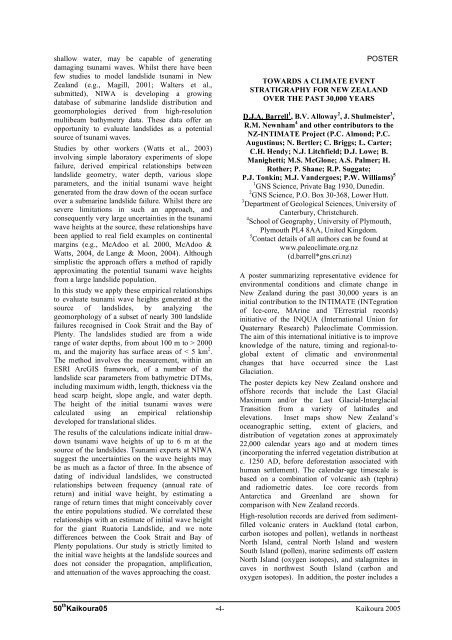50thKaikoura05 -1- Kaikoura 2005 CHARACTERISATION OF NEW ...
50thKaikoura05 -1- Kaikoura 2005 CHARACTERISATION OF NEW ...
50thKaikoura05 -1- Kaikoura 2005 CHARACTERISATION OF NEW ...
Create successful ePaper yourself
Turn your PDF publications into a flip-book with our unique Google optimized e-Paper software.
shallow water, may be capable of generating<br />
damaging tsunami waves. Whilst there have been<br />
few studies to model landslide tsunami in New<br />
Zealand (e.g., Magill, 2001; Walters et al.,<br />
submitted), NIWA is developing a growing<br />
database of submarine landslide distribution and<br />
geomorphologies derived from high-resolution<br />
multibeam bathymetry data. These data offer an<br />
opportunity to evaluate landslides as a potential<br />
source of tsunami waves.<br />
Studies by other workers (Watts et al., 2003)<br />
involving simple laboratory experiments of slope<br />
failure, derived empirical relationships between<br />
landslide geometry, water depth, various slope<br />
parameters, and the initial tsunami wave height<br />
generated from the draw down of the ocean surface<br />
over a submarine landslide failure. Whilst there are<br />
severe limitations in such an approach, and<br />
consequently very large uncertainties in the tsunami<br />
wave heights at the source, these relationships have<br />
been applied to real field examples on continental<br />
margins (e.g., McAdoo et al. 2000, McAdoo &<br />
Watts, 2004, de Lange & Moon, 2004). Although<br />
simplistic the approach offers a method of rapidly<br />
approximating the potential tsunami wave heights<br />
from a large landslide population.<br />
In this study we apply these empirical relationships<br />
to evaluate tsunami wave heights generated at the<br />
source of landslides, by analyzing the<br />
geomorphology of a subset of nearly 300 landslide<br />
failures recognised in Cook Strait and the Bay of<br />
Plenty. The landslides studied are from a wide<br />
range of water depths, from about 100 m to > 2000<br />
m, and the majority has surface areas of < 5 km 2 .<br />
The method involves the measurement, within an<br />
ESRI ArcGIS framework, of a number of the<br />
landslide scar parameters from bathymetric DTMs,<br />
including maximum width, length, thickness via the<br />
head scarp height, slope angle, and water depth.<br />
The height of the initial tsunami waves were<br />
calculated using an empirical relationship<br />
developed for translational slides.<br />
The results of the calculations indicate initial drawdown<br />
tsunami wave heights of up to 6 m at the<br />
source of the landslides. Tsunami experts at NIWA<br />
suggest the uncertainties on the wave heights may<br />
be as much as a factor of three. In the absence of<br />
dating of individual landslides, we constructed<br />
relationships between frequency (annual rate of<br />
return) and initial wave height, by estimating a<br />
range of return times that might conceivably cover<br />
the entire populations studied. We correlated these<br />
relationships with an estimate of initial wave height<br />
for the giant Ruatoria Landslide, and we note<br />
differences between the Cook Strait and Bay of<br />
Plenty populations. Our study is strictly limited to<br />
the initial wave heights at the landslide sources and<br />
does not consider the propagation, amplification,<br />
and attenuation of the waves approaching the coast.<br />
POSTER<br />
TOWARDS A CLIMATE EVENT<br />
STRATIGRAPHY FOR <strong>NEW</strong> ZEALAND<br />
OVER THE PAST 30,000 YEARS<br />
D.J.A. Barrell 1 , B.V. Alloway 2 ,J.Shulmeister 3 ,<br />
R.M. Newnham 4 and other contributors to the<br />
NZ-INTIMATE Project (P.C. Almond; P.C.<br />
Augustinus; N. Bertler; C. Briggs; L. Carter;<br />
C.H. Hendy; N.J. Litchfield; D.J. Lowe; B.<br />
Manighetti; M.S. McGlone; A.S. Palmer; H.<br />
Rother; P. Shane; R.P. Suggate;<br />
P.J. Tonkin; M.J. Vandergoes; P.W. Williams) 5<br />
1 GNS Science, Private Bag 1930, Dunedin.<br />
2 GNS Science, P.O. Box 30-368, Lower Hutt.<br />
3 Department of Geological Sciences, University of<br />
Canterbury, Christchurch.<br />
4 School of Geography, University of Plymouth,<br />
Plymouth PL4 8AA, United Kingdom.<br />
5 Contact details of all authors can be found at<br />
www.paleoclimate.org.nz<br />
(d.barrell*gns.cri.nz)<br />
A poster summarizing representative evidence for<br />
environmental conditions and climate change in<br />
New Zealand during the past 30,000 years is an<br />
initial contribution to the INTIMATE (INTegration<br />
of Ice-core, MArine and TErrestrial records)<br />
initiative of the INQUA (International Union for<br />
Quaternary Research) Paleoclimate Commission.<br />
The aim of this international initiative is to improve<br />
knowledge of the nature, timing and regional-toglobal<br />
extent of climatic and environmental<br />
changes that have occurred since the Last<br />
Glaciation.<br />
The poster depicts key New Zealand onshore and<br />
offshore records that include the Last Glacial<br />
Maximum and/or the Last Glacial-Interglacial<br />
Transition from a variety of latitudes and<br />
elevations. Inset maps show New Zealand’s<br />
oceanographic setting, extent of glaciers, and<br />
distribution of vegetation zones at approximately<br />
22,000 calendar years ago and at modern times<br />
(incorporating the inferred vegetation distribution at<br />
c. 1250 AD, before deforestation associated with<br />
human settlement). The calendar-age timescale is<br />
based on a combination of volcanic ash (tephra)<br />
and radiometric dates. Ice core records from<br />
Antarctica and Greenland are shown for<br />
comparison with New Zealand records.<br />
High-resolution records are derived from sedimentfilled<br />
volcanic craters in Auckland (total carbon,<br />
carbon isotopes and pollen), wetlands in northeast<br />
North Island, central North Island and western<br />
South Island (pollen), marine sediments off eastern<br />
North Island (oxygen isotopes), and stalagmites in<br />
caves in northwest South Island (carbon and<br />
oxygen isotopes). In addition, the poster includes a<br />
50 th <strong>Kaikoura</strong>05 -4- <strong>Kaikoura</strong> <strong>2005</strong>















